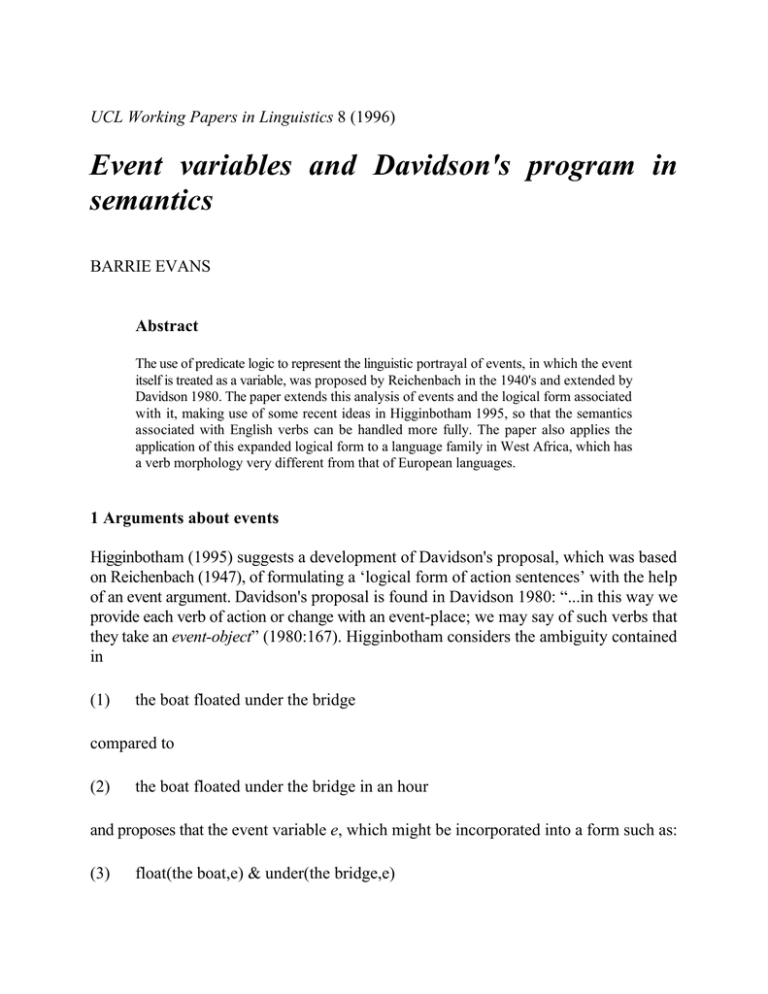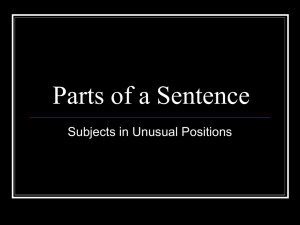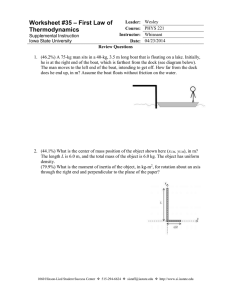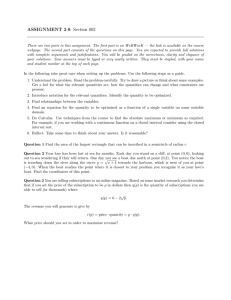Event variables and Davidson's program in semantics UCL Working Papers in Linguistics
advertisement

UCL Working Papers in Linguistics 8 (1996) Event variables and Davidson's program in semantics BARRIE EVANS Abstract The use of predicate logic to represent the linguistic portrayal of events, in which the event itself is treated as a variable, was proposed by Reichenbach in the 1940's and extended by Davidson 1980. The paper extends this analysis of events and the logical form associated with it, making use of some recent ideas in Higginbotham 1995, so that the semantics associated with English verbs can be handled more fully. The paper also applies the application of this expanded logical form to a language family in West Africa, which has a verb morphology very different from that of European languages. 1 Arguments about events Higginbotham (1995) suggests a development of Davidson's proposal, which was based on Reichenbach (1947), of formulating a ‘logical form of action sentences’ with the help of an event argument. Davidson's proposal is found in Davidson 1980: “...in this way we provide each verb of action or change with an event-place; we may say of such verbs that they take an event-object” (1980:167). Higginbotham considers the ambiguity contained in (1) the boat floated under the bridge compared to (2) the boat floated under the bridge in an hour and proposes that the event variable e, which might be incorporated into a form such as: (3) float(the boat,e) & under(the bridge,e) 2 Barrie Evans be considered rather as two event variables, process and telos (1995:16), so that (2) would have the form: (4) float(the boat,e1) & under(the bridge,e1,e2) & in an hour(e1,e2) The ambiguity in (1) would then be clarified by it having either the form in (5) or the form in (6) (5) float(the boat,e1) & under(the bridge,e1) (6) float(the boat,e1) & under(the bridge,e1,e2) The ambiguity is resolved by the preposition under taking either one or two event arguments. Higginbotham states that the phrase in an hour, as in (2) and (4), would be “constrained to measure the temporal difference between the two [arguments]” (1995:16). As Higginbotham points out: “it was one of the triumphs of Davidson's theory of the modification of verbs that it explained a number of obvious implications, e.g. that if the boat floated under the bridge, then it floated” (1995:14). Both (5) and (6) entail by simple deduction: (7) float(the boat,e1) For Davidson, it seems, such entailment relationships are important: “...the logical relations between sentences provide the only real test of when our language commits us to the existence of entities” (1980:203). 2 Getting there... In discussing the example in (2), Higginbotham also considers the example in (8): (8) the boat floated in an hour and states: “but now something has gone wrong, for although (8) is meaningful it has the wrong meaning. It does not mean that the boat got somewhere in an hour by floating Event variables 3 there, but that it took an hour for the boat to get to floating” (1995:15). That is to say, if we use two event arguments as was proposed for (2), in which in an hour is “constrained to measure the temporal difference between the two [arguments]”, we would have to write: (9) float(the boat,e2) & in an hour(e1,e2) in which e2, the telos, is used in the action predicate since, as Higginbotham expresses it, e1 is not an event of floating, but of getting to floating, and it is only at e2, the telos, that the attribute of floating starts. Float(the boat,e1) would not have the truth value we need. 3 ...and staying there Higginbotham adduces another example to demonstrate the need for the two event arguments he is proposing: (10) Mary returned to the United States again In discussing this example Higginbotham states: “now return is telic and therefore by hypothesis presents two arguments, or an ordered pair of arguments (e1, e2), to the semantics. The event e1 is that of Mary's progress toward the US border; and e2 is the state of being in the US...”. He resolves the ambiguity of (10) by stating: “the ambiguity then results depending on upon whether again takes for its subject the complex (e1, e2)... or only e2....” (1995:18). McCoard notes that there is a small class of verbs which can have a “state ensuing” (McCoard 1978:148). It seems that return is one such: McCoard uses the example of freezing. Two other verbs which show this behaviour are come and go. If we consider the two examples: (9) he came for an hour (10) he went for an hour the hour also spans this ‘ensuing state’. This is made clear if we use the perfect form: 4 Barrie Evans (11) he has gone for an hour In this case the hour may not have finished at the time of the utterance, nevertheless the going has already happened, as can be demonstrated by the fact that (12) is not contradictory: (12) he has gone for an hour; he went three minutes ago Consequently, whereas in the simple case of floating and like verbs with the phase in an hour it would appear that it should be e2 that fills the event-place in the action predicate, in the case of verbs such as return, come or go, when the phrase for an hour is present, it would seem that it should be e1. For a sentence such as (13), where both in and hour and for an hour are present, it would seem that a resolution to this problem is required in order for the correct event arguments to be made available to the temporal phrases. (13) Mary came in an hour for an hour A simple solution to this problem is to posit three event arguments rather than two - e0, e1 and e2. We propose that e0 is the preparatory facet to an event - the “getting to” as Higginbotham refers to it in discussing (8). We can now rewrite (9 as: (14) float(the boat,e1) & in an hour(e0,e1) In an hour is still “constrained to measure the temporal difference between two arguments” but now they are the preparatory facet to the event and the event as such. (4) can be rewritten as: (15) float(the boat,e1) & under(the bridge,e1,e2) & in an hour(e0,e1) The ambiguity of (1) can still be resolved by whether under takes one or two arguments, but now it is the event and its ensuing state: (16) float(the boat,e1) & under(the bridge,e1) (17) float(the boat,e1) & under(the bridge,e1,e2) Event variables 5 e1 in (17) is the brief event during which time the boat passes from not being under the bridge to being under the bridge.1 It would appear the entailments derivable from (14), (15), (16) and (17) are now consistent and Davidson's principle quoted above, concerning the logical relationships between sentences, upheld. The verbs come and go would receive logical forms, ignoring the specification of past time, such as: (18) Mary came in an hour come(Mary,e1) & in an hour(e0,e1) (19) Mary came for an hour come(Mary,e1 ) & for an hour(e1,e2) which results in correct entailments and enables a sentence such as (13) to receive a sensible logical form. (20) come(Mary,e1) & in an hour(e0 ,e1 ) & for an hour(e1,e2) 4 On being assertive A language sub-family which the author has been concerned with in Africa (the West Atlantic branch of the Niger-Congo family) has been described as having verb forms which express aspecto-modal features (Roberts 1991). The distinction which we have been developing here, between a preparatory facet to an event, the event as such and an ensuing state to the event, appears potentially to have an application in describing features of the verb forms of these languages. The Pular language spoken in Guinea, for instance, has four perfective verb forms. For the verb yahugol to go they are (we give approximate English translations): 1 float(the boat,e 0) and float(the boat,e 2) seem to be inferred rather than entailed; sentences can be contructed which inhibit them from being inferred, such as, in the case of e2, the boat floated under the bridge and sank. 6 Barrie Evans (21) Yaayaa yahi John go-PERF/12 ...(and) John went (and)... (22) Yaayaa yahii John go-PERF/2 John went/has gone (23) Yaayaa yahu John go-PERF/3 John went! (24) Yaayaa no yahi John STAT go-PERF/1 John has gone (somewhere) Parsons (1990) and Vlach (1993), following Davidson's original work, use a logical form in which the predications are bound by an existential operator: (25) (e)[.......] The core elements in the event, such as the subject and object, are also assigned separate predications: (27) Mary saw John (e)[see(e) & Subject(e,Mary) & Object(e,John)] which entails: (28) (e)[see(e) & Subject(e,Mary)] (29) (e)[see(e) & Object(e,John)] (30) (e)[Subject(e,Mary) & Object(e,John)] 2 PERF/1 - perfective-1, PERF/2 - perfective-2, PERF/3 - perfective-3, STAT - stative marker. Event variables 7 and so on for the simple predications. They also propose predications for the different facets or attributes of an event such as, in the case of Parsons, Hold(e,t) and Culminate(e,t). The details of Parsons’ use of these predications need not concern us here. What will concern us here is whether the proposal of section 3, namely to posit three subevent arguments rather than two, could be restated in this form. It seems that we can do this in a simple fashion by positing three predications: Event0(e,t), Event1(e,t) and Event2(e,t). Event0(e,t) would be true during e0 and false otherwise; likewise for Event1 (e,t) and Event2 (e,t). These predications appear to be useful in enabling some of the distinctions between the verb forms of this West Atlantic language to be written in a logical form. The perfective-2 verb form for instance (yahii in (22) above) is particularly used to denote a change of state. It appears that if a speaker assumes (‘projects’) that his interlocutor is aware that an event is or was in a preparatory event-state, the perfective-2 verb form is the appropriate verb form to use to denote that that event has now taken place.3 We will use the following additional notation. Following Sainsbury (1991:208) and Evans (1985:186) we will use a square-bracket notation to indicate scope, [e]. Sainsbury paraphrases this as: “it is true with respect to e that....”. We do this to make it clearer that the assertion does not concern the existence of the event in toto but rather the realisation of an element of it. u is the utterance time and u- a pragmatically interpretable time prior to utterance time. ,(e,t) is a function which is false prior to the event time and true after the event time; this event time ,, which is required for independent reasons,4 is understood as the time at which the event is considered to have irrevocably happened (during e1). Subscript j is an index which indicates that the speaker projects that the truth of this predicate is already part of his interlocutor's belief state. (31) [e][Subject(e,John) & Event0(e,u-)j & ,(e,u)] 3 Compare the description by Robert (1991) of the perfect or terminative verb form in Wolof, another West Atlantic language: “Le parfait indique l'état résultant: en T0 [temps et lieu de l'énonciation] le procès p a atteint dans le temps un terme quantitatif, visé au préalable, et tel qu'il ne présente désormais plus de variation... [p] est supposé connu et l'information porte sur l'atteinte de son terme”. Fal, Santos and Doneux (1990) give a similar description for Wolof: “Le terminatif... met l'accent sur l'aboutissement du procès. Ce sous-mode convient particulièrement lorsque l'on annonce un changement de situation; ceeb bi ñor na *le riz est cuit+; wér na *il est gueri+; meew mi way na *le lait a caillé+; ndox mi tàng na *l'eau est chaude+.” 4 It can be used, for instance, to distinguish the meaning of the Pular perfective-1 from that of the English perfect. Barrie Evans 8 There are a number of features of this particular logical form which require further investigation. However if the notation is understood as described above, (31) reflects one of the most important uses of this Pular perfective-2 verb form. The Pular stative perfective in (24) by contrast could be represented by the following logical form, in which J2(e,t) is a function reflecting the end time J2 of the ensuing state e2:5 (32) [e][Subject(e,John) & ,(e,u) & ~J2(e,u)] These two logical forms make precise some of the semantic differences between the Pular perfective-2 form and the Pular stative perfective. In the first place, if Event0(e,t), for a pragmatically interpretable prior time, is part of the speaker's projection of his interlocutor's belief state, then the Pular perfective-2 is more felicitous. If it is not, then there will be contexts where either the Pular perfective-2 or the Pular perfective stative can be used. If, on the other hand, J2, the end-time of e2, has been passed (that is to say the ensuing state is no longer in existence) the Pular stative perfective is no longer appropriate, although the Pular perfective-2 may still be able to be used. We will not further investigate the perfective-1 and the perfective-3 forms here. Perfective-3, in which the assertion is used to challenge a hearer-belief concerning the identification of the action-type of the event, <action>(e), can perhaps be treated in a similar fashion. Perfective-1 poses problems of a somewhat different nature as result of its overwhelming use in relating a sequence of actions. 5 A possible research orientation The logical forms in (31) and (32), corresponding to the Pular perfective-2 and Pular stative perfective, if they are correct, point out a certain polysemy that is contained in these verbal forms, and also that this polysemy has simultaneously temporal, aspectual and modal (assertive) features. It also shows that the meaning of these verbal forms is in a sense ‘relative’, relative to whether another logical form would be more felicitous, and relative to presuppositions that exist at that point in the discourse. 5 We could also define a set of onset times for these sub-events: T 0,T 1,T 2, (with corresponding functions: T 0(e,t), T 1(e,t), T 2(e,t).) In an hour and for an hour would then be able to be specified as being from T 0 to , and from , to J2 respectively. Event variables 9 Concerning an overall research orientation for this type of investigation, Higginbotham states: Donald Davidson urges us to investigate the semantic structure of given natural languages... It seems often to have been assumed that the relation between syntax and semantics is: syntax tells you what the sentences of a language are, and semantics only then comes along to tell you what these sentences mean.... However.... simple ambiguities show that principles of form and principles of interpretation are to be articulated together, and not in theoretical isolation; and explanations of semantic facts obviously require both syntactic and semantic premises. Davidson's program, as I understand it, stresses this intertwining of considerations of form and meaning (1984:2,46-47). Concerning the investigation of semantic values he states: I should like to distinguish three sorts of questions that typically arise when one is in the middle of a more or less specific inquiry into the semantic nature of constructions in natural language. The first of these questions concerns the nature of semantic values: the sorts of objects that should be taken as the values of these constructions, or of parts of them. The second is the proper form of syntax; what categories do elements belong to, and, according to what principles to they combine to form complex expressions? The third question... is: how, given one's assumptions about values, and given also an account of the modes of syntactic combination of words and phrases, do values get assigned to those words and phrases...I have spoken of semantics as a technical enterprise pursued against a background of assumptions both metaphysical and syntactic in nature. On the metaphysical side, it has been Davidson's view that the only values that both need to be posited and do useful work in combinatorial semantics are those of a referential character: denotation, satisfaction and truth (1984: 30). It is in light of such an exercise in ‘combinatorial semantics’ that the proposals of this paper need to be further evaluated, and their implications for a more fully developed event ontology appraised. 10 Barrie Evans References Davidson, D. (1980) Essays on Actions and Events. Oxford: Clarendon Press. Evans, G. (1985) Collected Papers Oxford: Clarendon Press. Fal, A., Santos, R. and Doneux, J. (1990) Dictionnaire wolof-français. Paris: Karthala. Higginbotham, J. (1984) Linguistic Theory and Davidson's Program in Semantics. ms., Cambridge, MA: MIT Press. Higginbotham, J. (1995) Sense and Syntax. Oxford: Clarendon Press. McCoard, J.D. (1978) The English Perfect in Tense Choice and Pragmatic Inferences. Amsterdam: North Holland Publishing. Parsons, T. (1990) Events in the Semantics of English: A Study in Subatomic Semantics. Cambridge, MA: MIT Press. Reichenbach, H. (1947) Elements of Symbolic Logic. New York: The Free Press. Robert, S. (1991) Approche Enonciative du Système Verbal: Le Cas du Wolof. Paris: Editions du Centre National de la Recherche Scientifique. Sainsbury, M. (1991) Logical Forms: An Introduction to Philosophical Logic. Oxford: Basil Blackwell. Vlach, F. (1993) Temporal Adverbials, Tenses and the Perfect? Linguistics and Philosophy 16: 231-283.






